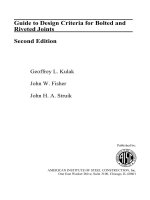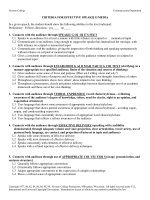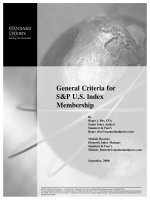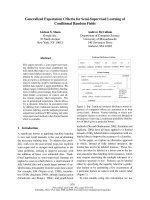gpn selection criteria for external auditors feb2008
Bạn đang xem bản rút gọn của tài liệu. Xem và tải ngay bản đầy đủ của tài liệu tại đây (128.3 KB, 13 trang )
Selection Criteria for External
Auditors
Part of a series of notes to help Centers review their own internal management processes
from the point of view of managing risks and promoting value for money, and to identify
where improvement efforts could be focused. The good practices described in this series
of notes should not be interpreted as minimum standards as not all may be applicable to
every Center.
SUMMARY
The purpose of this note is to provide guidance to Centers on the selection of external auditors and, as
such, supplements CGIAR Financial Guideline No. 3 (Auditing Guidelines Manual). The note draws on
recent examples of external auditor selection. The note recommends that criteria and their weightings
for external auditor selection should be established during the selection planning phase. The note also
recommends that a comprehensive Request for Proposal document be used to elicit effective and
competitive proposals from prospective firms.
Criterion weightings should ensure that technical criteria are decisive, with price determining the
selection only when technical rankings are close. Consistent with CGIAR Financial Guideline No. 6 on
Procurement, the criteria should be included in the requests for proposal given to prospective firms to
encourage responsive bids and promote transparency in the selection process. Technical criteria should
be assessed before price is considered.
Acknowledgements
This note has been prepared solely for use by CGIAR Centers and their internal auditors. We thank
CGIAR Center managers and staff who provided input and advice on the preparation of this note.
The sample Request for Proposal attached to this note derives from one developed collaboratively
with ICARDA
Good Practice Note – Selection Criteria for External Auditors 1
Good Practice Note – Selection Criteria for External Auditors 2
Selection Criteria for External
Auditors
INTRODUCTION
CGIAR Financial Guideline No. 3 on Audit (FG3) provides that the Center external auditor be rotated
every 5-7 years. Section 2.27 of FG3 provides that the Centers may wish to consider the following
criteria when selecting a new external auditor:
• The personnel size and qualifications of the firm in the host country;
• The firm’s clientele;
The firm’s proven and•
he purpose of this note is to provide guidance to Centers on the selection criteria to supplement
ples of external auditor selection in a number of Centers.
nal audit should be evaluated on
Consistent with CGIAR Financial Guideline No. 6 on
rocurement, the criteria should be included in the requests for proposal given to prospective firms to
demonstrated experience in auditing international nonprofit organizations in
the host country; and
• The firm’s audit methodology, approach, and use of information technology (IT) tools.
T
CGIAR FG 3. The note draws on recent exam
Good practice
Establish criteria and weightings for the external auditor selection during the selection planning
phase
Generally, external audit firms proposing to bid for the Center’s exter
the basis of
• Written proposal submitted in response to a request for proposal
• Presentation(s)
• Any clarifications submitted by the firm concerning the above
Performance of bidders against the selection criteria should be assessed based on all three sources.
Criteria weightings should ensure that technical criteria are decisive, with price determining selection
only when technical rankings are close.
P
Good Practice Note – Selection Criteria for External Auditors 3
ould
Suggested selection criteria consistent with the recommendations of FG3, items to consider when
Ov
Affiliation with worldwide firm–nature of professional quality assurance and other interactions to
ensure that international auditing standards are maintained as they are evolving (including impacts of
the U.S. Sarb
rting
ernational financial reporting standards (IFRS – formerly IAS)
the audit of the Center (e.g., IT, enterprise risk
management)
• Types of clients/sectors, number of large clients/client spread (not overly reliant on few clients)
encourage responsive bids and promote transparency in the selection process. Technical criteria sh
be assessed before price is considered.
evaluating against the criteria and criteria weightings, are set out below:
erall capabilities of the firm (suggested weighting: 10%)
•
anes-Oxley Act and similar requirements in other countries).
What is an “internationally recognized audit firm?
CGIAR FG3 Section 2.25 states that all external auditors of the Centers “must be from one of the
internationally recognized (e.g., Big-5) public accounting firms”. Since the publication of the latest
version of FG3, the Big 5 has shrunk to the Big” with the demise of Arthur Andersen. FG3 leaves
open the possibility of one of the so-called second-tier international firms being appointed Center
external auditor. With only four firms in the first tier and these firms not being strong in the host
country or region of the Center, there is growing interest in considering second tier firms where
they have a significant presence in the host country and may have provided satisfactory services to
the Center in other capacities. At this time, the gap between the Big 4 and the second-tier of
international firms is still perceived to be significant, with second tier firms yet to establish the
organizational structures that bind member firms and the levels of quality assurance of the Big 4,
but this is subject to change. The impact on the perceptions of current and potential donors of
ha ing a second-tier firm as Center external auditor will be an important consideration in selectinv g
such a firm.
• Presence of offices in other countries where the Center has operations/offices, and the ease with
which those offices could be called on where necessary
• Experience in audit of not-for-profit organizations/international organizations/enterprises repo
according to int
Number of partners and professional staff; partner-staff ratio, ability to substitute staff at similar
levels of qualifications and experience if necessary
•
• Firm specialties that may be advantageous to
Good Practice Note – Selection Criteria for External Auditors 4
ility of the firm to
Pro
-level staff, auditor-in-charge
(AiC) and junior staff; whether the team includes staff qualified to review IT systems)
rofessional and academic
or other CGIAR Centers?
d weighting: 20%)
e this fitting in with the Institute’s own risk
management activities?
• een interim and final audits
•
Understanding of the assignment (suggested weighting: 20%)
red to not-for-profit, international organization
hat would affect the audit and ability of the Center to report
against IFRS (via compliance with CGIAR Financial Guideline No. 2)
• Any legal actions or reputational issues relating to firm that may impact the ab
provide services to the Center
• Feedback on performance from other clients
fessional team assigned (suggested weighting: 20%)
• Organization of team (lead partner, review partner, number of manager
• The curriculum vitae of lead partner, review partner, manager(s), AiC – p
qualifications, years of external audit experience, recent professional development activities,
experience with audit of not-for-profit entities, experience with auditing against international
financial reporting standards, any experience with the Center
• Number of hours allocated in proposal by partners, managers and AiC
Proposed methodology (suggeste
• Risk assessment methodology–how would they se
• Balance between reviews of controls and substantive testing
• Reporting approach–interim reports, management reports, presentations to management and Board
Number of hours allocated to the assignment, breakdown betw
• Number of visits to the Center for the audit
Approach to reviewing the financial system
• Proposed interaction with internal audit function
• Familiarity or at least knowledge of types of financial reporting and control issues facing an entity
like the Center
• Approach tailo
• Ability to audit against IFRS and according to international auditing standards, understanding what
this entails
• Ability to identify important risks t
Costs (suggested weighting: 30% Upper and lower bounds to acceptable
fees may be set to avoid the result being skewed by unrealistically low or
high fee proposals)
Good Practice Note – Selection Criteria for External Auditors 5
Proposed fee
e number of hours (should be neither excessive nor low that the quality of the audit
ket expenses
n should be included in the
urage responsive bids and promote transparency
Using a comprehensive Request for Proposal format, that provides background information on the
Center, the CGIAR financial reporting and audit requirements, and the nature and volume of financial
activities of the Center will help elicit proposals from external audit firms that:
• effectively respond to Center requirements and are competitive in terms of service and price; and
• ensure proposals are submitted that can be easily compared to each other.
A model Request for Proposal is annexed to this note.
•
• Relationship to th
or ability of the firm to deliver within the fee is doubted)
• Estimated out-of-poc
Good practice
Include selection criteria in the request for proposal given to prospective firms
o sistent with CGIAR Financial Guideline No. 6 on Procurement, the criteriaC
requests for proposal given to prospective firms to enco
n the selection process. i
Good practice
Adopt a comprehensive Request for Proposal format to elicit effective and competitive proposals
from prospective firms
Good Practice Note – Selection Criteria for External Auditors 6
Annex 1
MODEL REQUEST FOR PROPOSAL FOR EXTERNAL AUDIT SERVICES
Office of the Director General
Date
Mr. /Ms. …
………
…………
Dear Mr. /Ms. ……,
The [Center] wishes to invite proposals from internationally recognized accounting firms for the conduct
of the external audit of the Center, and we extend this invitation to your firm. If you are interested, we
would appreciate receiving a written proposal from your firm, comprising technical and financial
components.
A detailed request for proposal is attached to this letter.
Please note that the cost of preparing a proposal shall be borne by the offeror, regardless of the outcome
of the solicitation process. The proposal should be submitted on or before …………. If you wish to
obtain further information about this invitation, please contact ………… (email: ………;
tel………… )
We look forward to receiving your proposal.
Yours sincerely,
………
Director General
Good Practice Note – Selection Criteria for External Auditors 7
REQUEST FOR PROPOSAL FOR THE ANNUAL EXTERNAL AUDIT
INTRODUCTION
1. Established in 19 , the [Center] is one of 15 centers strategically located all over the world and
supported by the Consultative Group on International Agricultural Research (CGIAR). Information
about the operations of [Center] can be obtained from www…….org. The CGIAR is a consortium of
donors comprising national governments, international institutions and private foundations. The centers
supported by the CGIAR conduct scientific research and training activities, in agriculture and related
fields, to achieve sustainable food security and to reduce poverty in developing countries. Information
about the CGIAR can be obtained from www.cgiar.org.
2. The center is an autonomous entity, with an international board of trustees, established as a …….
/under a [charter] in 19 [Center] has the status and privileges and immunities of an international
organization under its host country agreement with … as well as with various other countries in which
it conducts research and training.
3. With its main [research station and] offices based in ……., [Center] works through a network of
partnerships with national, regional and international institutions, universities, non-governmental
organizations and governments in the developing world, and advanced research institutes in
industrialized countries.
4. [Center]’s mission is to ………………….
5. [Center] serves the entire developing world for ……….
6. In addition to its headquarters in …., [Center] maintains offices and facilities in……….
7. [Center] is funded by … donors. The total revenue in 200 was US$ million. An indicative
financial transaction volume is as follows:
cash vouchers ….
journal vouchers ….
bank transactions ….
ACCOUNTING, FINANCIAL REPORTING AND AUDIT ARRANGEMENTS
8. As a Center supported by the CGIAR, [Center] adheres to a common set of governance
principles and financial guidelines. These include guidelines on financial reporting and audit. As with
Good Practice Note – Selection Criteria for External Auditors 8
all CGIAR Centers, [Center] prepares financial statements in accordance with a CGIAR Accounting
Policies and Reporting Practices Manual (Financial Guidelines Series No. 2). The Manual requires the
Centers to fully adopt International Financial Reporting Standards (IFRS) as issued by the International
Accounting Standards Board, as well as make various CGIAR-specific disclosures in its annual financial
statements. The CGIAR Auditing Guidelines Manual (Financial Guidelines Series No. 3) requires the
Centers’ annual financial statements to be subject to independent external audit carried out in
accordance with International Standards on Audit published by the International Audit Practices
Committee of the International Federation of Accountants. Copies of these and other CGIAR Financial
Guidelines can be obtained from
www.cgiar.org/publications/finguide/index.html
9. In addition, [Center] is also required, under the terms of some donor agreements entered into for
specific research or related projects, to prepare project-specific financial statements according to formats
stipulated by the donor, and have these independently audited.
10. The Center’s financial accounts are maintained in [system]. [Note here any planned or current
system changes].
11. All outreach locations except …. submit original accounting documents to headquarters where
the financial transactions are processed. [Note here any cases where outreach offices maintain their own
separate accounting system and original documents, where a financial statement for this location is
consolidated with that prepared at Headquarters to produce a Center-wide financial statement].
12. [Center} has an internal audit function provided by [an in house unit/outsourced, the CGIAR
Internal Auditing Unit (IAU), or jointly by the two].
REQUIREMENTS FOR EXTERNAL AUDIT
13. The requirements for the external audit of [Center] will include the following:
• Examination of the financial statements according to International Standards on Auditing and
issue of an opinion thereon in relation to the IFRS and CGIAR FG2;
• Preparation of a memorandum on the review of internal accounting controls and other ma
arising from the audit which
tters
should be brought to the attention of the Center’s Board of
• counting, tax and
new pronouncements/policies promulgated by accounting standard setters, the CGIAR and
other organizations, where these are considered applicable to the Center.
Trustees and management;
• Presentation to the Board of Trustees’ Audit Committee of the audit report and findings;
• [where permitted locally] Signature of the audit report on the financial statements under the
international name of the firm;
Routine consultation with [Center]’s financial team on developments in ac
Good Practice Note – Selection Criteria for External Auditors 9
a senior partner who would have overall responsibility in
e firm for the quality and timeliness of the audit assignments, and for formal communication on the
to respond to this proposal must disclose in their proposal any
urrent situations or existing client relationships that may give rise to perceived or actual conflicts of
ish.
on the basis of the following technical and financial criteria:
e firm
sed methodology
ost
roposal should address the technical criteria above. In this
gard, the proposal should include a completed questionnaire (Appendix 1 of this Request for Proposal)
6. The financial proposal (for fee and estimated “out of pocket” expenses) must be supported with
nts of the written proposal must be submitted in both hard copy
e following addresses:
ard copy - (Center mail address here)
of the Board of Trustees in …… 200 The Audit Committee and the Board of Trustees will
make a decision on the final selection of the external auditor and the decision will be communicated by
…. 200
PREPARATION AND SUBMISSION OF PROPOSAL
14. During preparation of the written proposal, you must give particular attention to the following:
[Center] requires that the offeror to nominate
th
assignment between the firm and the center.
[Center] requires that an offeror wishing
c
interest in undertaking the assignment.
The working language of [Center] is English and the reporting for the audit will be in Engl
[Center] will asses proposals
Overall capabilities of th
Professional team assigned
Propo
Understanding of the assignment
C
Any other specific criteria that may be deemed pertinent during the selection process
15. The technical component of the p
re
covering various aspects of the criteria.
1
an appropriate breakdown analysis.
17. Technical and financial compone
and electronic format to …………….at th
H
Electronic copy – (email addresses here)
18. Upon receipt of your proposal the Center will evaluate it and you may be requested to provide
additional information as needed. If you are shortlisted, you will invite to make a presentation to Audit
Committee
Good Practice Note – Selection Criteria for External Auditors 10
Appendix 1 of the RFP
QUESTIONNAIRE FOR OFFERORS
Overall Capabilities of the Firm Response
1. What is the size of the firm from which the audit
would be performed? Please provide information on
the number for each level of professional staff in the
firm, partner/staff ratio and the number of audits
performed annually by the office.
2. How many clients does the firm have, in what
sectors does the client base predominate, is the client
base dominated by a few clients, and what is the
geographical spread of clients?
3. What experience does the firm have in auditing
non-profit organization especially those involved in
agricultural research or similar endeavors such as
universities?
4. What experience does the firm have in relation to
such clients, where the clients must report in
accordance with International Financial Reporting
Standards?
5. What experience does the firm have in auditing
clients who use [financial system]?
6. What is the firm’s internal quality control
procedures for specific audit assignments and the
firm’s quality assurance program? When was the
firm last subject to an independent quality assurance
review and what was the nature of that review?
7. What is the nature of the firm’s affiliation with
its worldwide firm?
8. What is the nature of the firm’s access to the
worldwide firm’s knowledge base, quality assurance
system, professional development and other
resources to support its work?
9. Does the worldwide firm have a presence in the
countries in which the Center has offices or
facilities? How could the availability of such an
international network assist with the cost-effective
completion of Center audits?
Good Practice Note – Selection Criteria for External Auditors 11
10. Does the firm have an internal staff rotation
policy? If so what is the period of rotation of
partner/managers/auditor in charge for assignments
in your firm?
11. What arrangements does the firm have to ensure
that if key personnel (partners, managers, auditors in
charge, specialist auditors) proposed for the audit
can not be made available, must be substituted
during the course of the engagement, or must rotate
in accordance with the firm’s rotation policy, that
similarly qualified and experienced staff can be
assigned in their place in a timely fashion?
12. Are there any legal actions or potential conflicts
of interest relating to the firm that may impact the
ability of the firm to provide services to the Center?
13. Can the firm provide client references to support
its proposal?
Professional Team Assigned
14. What are the size, composition and organization
of the professional team proposed for this
assignment? Please provide the CVs of the proposed
partners, managers, auditors-in-charge and any
specialist auditors. Note the professional and
academic qualifications, years of external audit
experience, recent professional development
activities, experience with audit of not-for-profit
entities, experience with auditing against
international financial reporting standards, and any
experience with the audit of the Center or other
CGIAR Centers
15. What is the time allocation for the various
proposed members of the professional team? Please
provide a time breakdown by interim and final audit
phases.
16. What would be the nature and extent of the
involvement of the proposed partners and managers
and any specialist auditors in the performance of the
Center’s audits in the interim and final audit phases?
Good Practice Note – Selection Criteria for External Auditors 12
Proposed Methodology
17. What is the firm’s approach to incorporating
risk assessment into the planning and conduct of
financial statement audits? How would this be
expected to integrate with the client’s own risk
management processes?
18. What is the firm’s approach to incorporating
reviews of the corporate governance arrangements of
the Center and the control environment – against
good international practice – into the planning and
conduct of the financial statement audits?
19. What is the firm’s approach to incorporating
reviews of compliance with host country agreements
and other applicable host country laws and
regulations into the planning and conduct of the
financial statement audits?
20. What is the firm’s approach to the balance of
internal control review versus substantive testing for
financial statement audits?
21. What is the firm’s approach to reviewing the
computerized and manual controls over the financial
reporting system, including review of the financial
system?
22. To what extent does the proposed audit
methodology enable the office to provide advice to
the Center on internal control processes particularly
as they relate to fraud elimination (prevention/
detection), efficiency of operations, risk reduction
and compliance with Center financial and related
policies?
23. What is the office’s reporting approach as they
relate to interim as well as final phases of the audit,
and presentations to client management and Boards?
24. What is the office’s proposed approach to
interaction with the internal audit activity of the
Center?
Understanding of the Assignment
25. What, in the office’s opinion, are the greatest
risks for financial integrity and internal control for
an enterprise like the Center (non-profit research,
university or similar organizations)?
26. What, in the office’s opinion, are the greatest
challenges to an enterprise like the Center
implementing IFRS?
27. What features, if any, of the proposed audit
approach does the office wish to highlight in terms
of tailoring to the Center’s needs as an international
non-profit organization which must report according
to IFRS?
28. What processes or access to knowledge
databases does the office provide to keep the clients
informed of the recent developments in the fields as
external audit, IFRS, internal audit, financial
management, corporate governance, enterprise risk
management?
Cost
29. What is the proposed fee to perform the Center’s
annual audit?
30. For how many years can the proposed fee(s) be
kept at the same level?
31. What would be the basis for fee increases in
subsequent years?
32. What are the estimated “out of pocket” expenses
to perform the Center’s annual audit? Please
provide a breakdown of estimate by relevant
expense categories.
33. What fee(s) would be charged to perform a
donor requested audit of project financial
statements? For this purpose the office may quote
fees for different categories of projects by financial
size.
34. What are the estimated “out of pocket” expenses
for these project audits? Please provide a
breakdown as per 30. above
Exposure Draft: August 2004
First Update: March 2005
Author: John Fitzsimon
Good Practice Note – Selection Criteria for External Auditors 13









